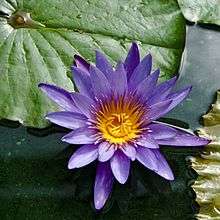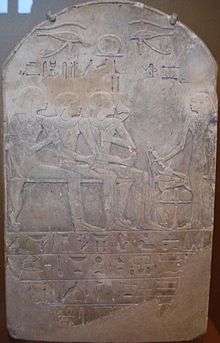Nymphaea caerulea
| Nymphaea caerulea | |
|---|---|
 | |
| A Nymphaea caerulea flower in Jardins des Martels, France. | |
| Scientific classification | |
| Kingdom: | Plantae |
| (unranked): | Angiosperms |
| Order: | Nymphaeales |
| Family: | Nymphaeaceae |
| Genus: | Nymphaea |
| Species: | N. caerulea |
| Binomial name | |
| Nymphaea caerulea Sav.[1] | |
Nymphaea caerulea, known primarily as blue lotus (or blue Egyptian lotus), but also blue water lily (or blue Egyptian water lily), and sacred blue lily (or sacred narcotic lily of the Nile), is a water lily in the genus Nymphaea. Like other species in the genus, the plant contains the psychoactive alkaloid apomorphine. It was known to the Mayan and Ancient Egyptian civilizations.
Distribution
Its original habitat may have been along the Nile and other parts of East Africa. It spread more widely in ancient times, including to the Indian subcontinent and Thailand.
Description
The leaves are broadly rounded, 25–40 cm across, with a notch at the leaf stem. The flowers are 10–15 cm in diameter.
Reports in the literature by persons unfamiliar with its actual growth and blooming cycle have suggested that the flowers open in the morning, rising to the surface of the water, then close and sink at dusk. In fact, the flower buds rise to the surface over a period of two to three days, and when ready, open around 9:30 am and close about 3:00 pm. The flowers and buds do not rise above the water in the morning, nor do they submerge at night. The flowers have pale bluish-white to sky-blue or mauve petals, smoothly changing to a pale yellow in the centre of the flower.
Religion and art

Along with the white lotus, Nymphaea lotus are also native to Egypt. The plant and flower are very frequently depicted in Egyptian art. They have been depicted in numerous stone carvings and paintings, including the walls of the famous temple of Karnak, and are frequently depicted in connection with "party scenes", dancing or in significant spiritual or magical rites such as the rite of passage into the afterlife. N. caerulea was considered extremely significant in Egyptian mythology, regarded as a symbol of the sun, since the flowers are closed at night and open again in the morning. At Heliopolis, the origin of the world was taught to have been when the sun god Ra emerged from a lotus flower growing in "primordial waters". At night, he was believed to retreat into the flower again.[2] Due to its colour, it was identified, in some beliefs, as having been the original container, in a similar manner to an egg, of Atum, and in similar beliefs Ra, both solar deities. As such, its properties form the origin of the "lotus variant" of the Ogdoad cosmogeny. It was the symbol of the Egyptian deity Nefertem.[3]
Properties and uses
Some evidence indicates the clinical effects of plants including N. caerulea that contain the psychoactive alkaloid apomorphine were known to both the Mayans and the Ancient Egyptians.[4]
The mildly sedating effects of N. caerulea makes it a likely candidate (among several) for the lotus plant eaten by the mythical Lotophagi in Homer's Odyssey.
This lotus has been used to produce perfumes since ancient times; it is also used in aromatherapy.
Legal status
Latvia
N. caerulea is illegal in Latvia since November 2009. It is schedule 1 drug. Possession of quantities up to 1 gram are fined up to 280 euros, for second offences within a year period criminal charges are applied. Possession of larger quantities can be punished by up to 15 years in prison.[5]
Poland
N. caerulea was banned in Poland in March 2009. Possession and distribution lead to a criminal charge.[6]
Russia
N. caerulea is illegal in Russia since April 2009 along with spice and related products, Salvia divinorum, Argyreia nervosa, and others.[7]
See also
- Nymphaea lotus, the Egyptian white water lily
- Nymphaea nouchali, the star lotus
- Palmette
- Fleur-de-lis
- Sacred Weeds, a Channel 4 TV series examining the effects of various psychoactive plants (including the blue lily) on volunteers
References
- ↑ "Nymphaea caerulea information from NPGS/GRIN". www.ars-grin.gov. Retrieved 2008-12-04.
- ↑ Rawson, Jessica, Chinese Ornament: The lotus and the dragon, pp. 200 (quoted)–202, 1984, British Museum Publications, ISBN 0-714-11431-6
- ↑ Wilkinson, Richard H. (2003). The Complete Gods and Goddesses of Ancient Egypt. Thames & Hudson. p. 133. ISBN 0-500-05120-8.
- ↑ Bertol, Elisabetta; Fineschi, Vittorio; Karch, Steven B.; Mari, Francesco; Riezzo, Irene (2004). "Nymphaea cults in ancient Egypt and the New World: a lesson in empirical pharmacology". Journal of the Royal Society of Medicine. 97 (2): 84–85. doi:10.1258/jrsm.97.2.84. PMC 1079300
 .
. - ↑ "Par Krimināllikuma spēkā stāšanās un piemērošanas kārtību" (in Latvian). likumi.lv. Retrieved 2013-06-23.
- ↑ (Polish) Dz.U. 2009 nr 63 poz. 520, Internetowy System Aktów Prawnych.
- ↑ "Постановление Правительства Российской Федерации от 31 декабря 2009 г. № 1186". 2009. Archived from the original on 2012-03-25.
External links
![]() Media related to Nymphaea caerulea at Wikimedia Commons
Media related to Nymphaea caerulea at Wikimedia Commons